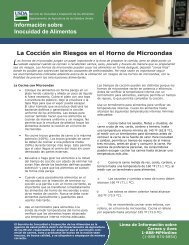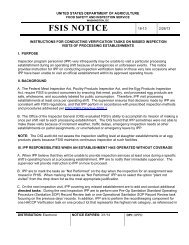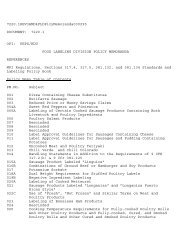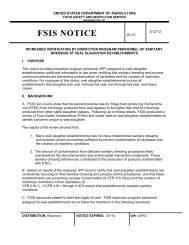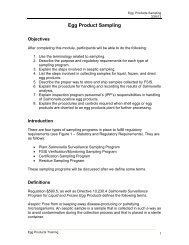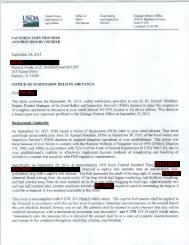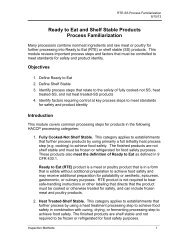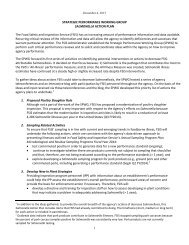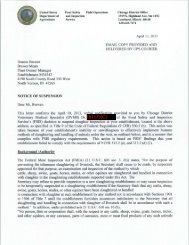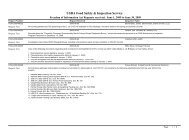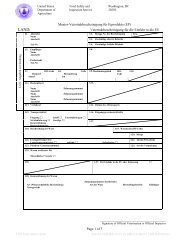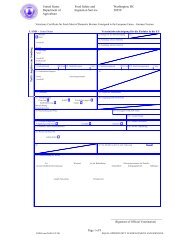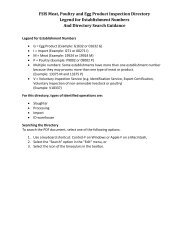Poultry Processing Inspection System - Food Safety and Inspection ...
Poultry Processing Inspection System - Food Safety and Inspection ...
Poultry Processing Inspection System - Food Safety and Inspection ...
Create successful ePaper yourself
Turn your PDF publications into a flip-book with our unique Google optimized e-Paper software.
United States<br />
Department of<br />
Agriculture<br />
<strong>Food</strong> <strong>Safety</strong><br />
<strong>and</strong> <strong>Inspection</strong><br />
Service<br />
Washington, D.C.<br />
20250<br />
Li Chunfeng<br />
Deputy Director General<br />
General Administration of Quality Supervision,<br />
<strong>Inspection</strong> <strong>and</strong> Quarantine (AQSIQ)<br />
Beijing, People's Republic of China<br />
AUG 3 0 2013<br />
Dear Dr. Li:<br />
The <strong>Food</strong> <strong>Safety</strong> <strong>and</strong> <strong>Inspection</strong> Service (FSIS) of the United States Department of Agriculture<br />
(USDA) conducted an on-site verification audit ofthe People' s Republic of China (PRC)<br />
poultry processing inspection system from March 4-19, 2013. FSIS submitted the draft audit<br />
report on June 28, 2013 <strong>and</strong> PRC responded on August 29, 2013 with a few minor suggestions.<br />
The draft audit report was update with your suggestions. Enclosed is a copy of the final audit<br />
report for poultry processing inspection system. This report was published on the FSIS website<br />
(http://wvvw.fsis.usda.gov) on August 30,2013.<br />
As all outst<strong>and</strong>ing issues have been resolved, the PRC may proceed with certifying a list of<br />
poultry processing establishments as meeting the FSIS requirements. These certified<br />
establishments may then begin exporting processed (heat-treated/cooked) poultry products to<br />
the United States under the conditions established in FSIS' April 2006 final rule; i.e. only<br />
processed poultry products produced from poultry slaughtered under FSIS inspection in the<br />
United States or in a country eligible to export slaughtered poultry to the United States.<br />
If you have any questions, please contact me at telephone number 202-720-6400, facsimile<br />
number 202-720-7990, or by e-mail at internationalequivalence@fsis.usda.gov.<br />
9;ls~:V -<br />
Andreas Keller {:; ~<br />
Director<br />
International Equivalence Staff<br />
Office of Policy Program Development<br />
Enclosure
Dr. Li Chunfeng<br />
2<br />
Scott SiridelaT, US Embassy, Beijing, China<br />
Ralph Bean, Acting minister Counselor for Agriculture Affairs<br />
Michael Riedel,- Senior Attache<br />
Ryan R. Scott, Agricultural Attache<br />
Morgan Perkins, F AS, North Asia Area Director<br />
Casey Bean, OASA, F AS<br />
Catherine Fulton, OASA, F AS<br />
Cecilia S. Choi, EB, State Department<br />
AI Almanza, Administrator, FSlS<br />
Carmen Rottenberg, Acting Chief of Staff, OA<br />
William C. Smith, Asst. Administrator, OlEA<br />
Jane Roth, Deputy Asst. Administrator, OlEA<br />
Vincent Fayne, Director, MCAD, OlEA<br />
Dee Dee Fumey, FSlS, OA<br />
Daniel Engeljolm, Asst. Administrator, OFO<br />
Rachel Edelstein, Assistant Administrator, OPPD<br />
Soumaya Tohamy, Deputy Asst. Administrator, OPPD<br />
Mary Stanley, Director, IPD, OPPD<br />
Ronald K. Jones, Deputy Asst. Administrator, OFO<br />
Andreas Keller, Director, IES, OPPD<br />
Rick Hanies, Director, EPS, OPPD<br />
Rita Kishore, Deputy Director, EPS, OPPD<br />
Linda Chittum, Acting Director, liD, OFO<br />
Shaukat Syed, Director, lAS, OlEA<br />
Francisco Gonzalez, lAS, OlEA<br />
Cham1aine McGee, EPS, OPPD<br />
Priya Kadam, IES, OPPD<br />
FSIS:OIA:lES:PKadam: China<strong>Poultry</strong><strong>Processing</strong>FinalAuditReportLetter08-30-2013.docx
FINAL REPORT OF AN AUDIT CONDUCTED IN<br />
TI-IE PEOPLE'S REPUBLIC OF CHINA<br />
March 4 through 19, 2013<br />
FSIS AUDIT OF THE FOOD SAFETY SYSTEM GOVERNING<br />
THE PRODUCTION OF PROCESSED POULTRY<br />
INTENDED FOR EXPORT TO<br />
THE UNITED STATES OF AMERICA<br />
<strong>Food</strong> <strong>Safety</strong> <strong>and</strong> <strong>Inspection</strong> Service<br />
United States Department of Agriculture<br />
1
Executive Summmy<br />
This audit report describes the outcome of an on-site corrective action verification audit<br />
conducted by the U.S. Department of Agriculture's (USDA) <strong>Food</strong> <strong>Safety</strong> <strong>and</strong> <strong>Inspection</strong> Service<br />
(FSIS) on March 4-19, 2013, to determine whether the People's Republic of China's (PRC) food<br />
safety system governing poulh·y processing remains equivalent to that of the United States<br />
(U.S.), with the ability to produce products that are safe, wholesome, unadulterated, <strong>and</strong> properly<br />
labeled. This audit was necessary to assess the effectiveness of the corrective actions the PRC<br />
submitted in response to the December 1-21, 2010, verification audit. The March 2013 poultry<br />
processing audit was conducted concunetitly with an equivalence audit of the PRC's poultry<br />
slaughter inspection system, for which the observed findings are included in a separate report.<br />
Representatives from the Certification <strong>and</strong> Accreditation Administration (CNCA), China<br />
<strong>Inspection</strong> <strong>and</strong> Quarantine (CIQ) Sh<strong>and</strong>ong province, <strong>and</strong> USDA's Foreign Agricultural Service<br />
(F AS) accompanied the FSIS auditors during the audit.<br />
The audit focused on the ability of the Central Competent Authority (CCA), the General<br />
Administration for Quality <strong>and</strong> <strong>Safety</strong> <strong>Inspection</strong> <strong>and</strong> Quarantine (AQSIQ), to regulate processed<br />
poultry production. FSIS audited four poultry processing establishments, the CCA headquarters,<br />
<strong>and</strong> the CIQ Sh<strong>and</strong>ong province govenunent offices. Detenninations concerning the<br />
effectiveness of the PRC's food safety program focused on perfom1ance within the following six<br />
equivalence components: (1) Govenunent Oversight, (2) Statutory Authority <strong>and</strong> <strong>Food</strong> <strong>Safety</strong><br />
Regulations, (3) Sanitation, (4) Hazard Analysis <strong>and</strong> Critical Control Point <strong>System</strong>s, (5)<br />
Chemical Residue Programs, <strong>and</strong> (6) Microbiological Testing Programs.<br />
Based on the analysis of the corrective actions submitted by the PRC in response to the 2010<br />
audit <strong>and</strong> the results of the 2013 audit, FSIS concludes that the CCA has adequately addressed all<br />
previously identified concems. Therefore, the PRC's processed poultry inspection system meets<br />
the equivalence components for FSIS equivalence criteria. Because all outst<strong>and</strong>ing issues have<br />
been resolved, the PRC may proceed with certifying a list of establishments eligible to export<br />
processed (heat-treated/cooked) poultry products to the United States, as long as the raw poultry<br />
is sourced from countries that FSIS determined to have a poultry slaughter inspection system<br />
equivalent to the U.S. system.<br />
FSIS submitted the draft audit report to PRC on July 1, 2013 <strong>and</strong> PRC responded on August 29,<br />
2013 with no substantive issues with the report.<br />
2
TABLE OF CONTENTS<br />
1. INTRODUCT-ION<br />
2. AUDIT OBJECTIVE, SCOPE, AND METHODOLOGY<br />
3. LEGAL BASIS FOR THE AUDIT<br />
4. BACKGROUND<br />
5. GOVERNMENT OVERSIGHT<br />
6. STATUTORY AUTHORITY AND FOOD SAFETY REGULATIONS<br />
7. SANITATION<br />
8. HAZARD ANALYSIS AND CRITICAL CONTROL POINT SYSTEMS<br />
9. CHEMICAL RESIDUE PROGRAMS<br />
10. MICROBIOLOGICAL TESTING PROGRAMS<br />
11. EXIT MEETING<br />
12. CONCLUSIONS<br />
13. ATTACHMENTS TO THE AUDIT REPORT<br />
3
ABBREVIATIONS AND SPECIAL TERMS USED IN THE REPORT<br />
AI-IVB<br />
AQSIQ<br />
CCA<br />
CFR<br />
CIQ<br />
CNAS<br />
CNCA<br />
E. coli<br />
FSB<br />
FSL<br />
FSIS<br />
GB<br />
HACCP<br />
Lm<br />
MOA<br />
MOI-l<br />
PPIA<br />
PRC<br />
RTE<br />
Salmonella spp.<br />
SSOP<br />
u.s.c.<br />
Animal Husb<strong>and</strong>ry <strong>and</strong> Veterinary Bureau<br />
Administration of Quality <strong>and</strong> Supervision <strong>and</strong> <strong>Inspection</strong> Quarantine<br />
Central Competent Authority (AQSIQ)<br />
Code ofFederal Regulations<br />
China <strong>Inspection</strong> <strong>and</strong> Quarantine Authority (Branch <strong>and</strong> Provincial)<br />
China National Accreditation Service for Conformity Assessment<br />
Certification <strong>and</strong> Accreditation Administration<br />
Escherichia coli<br />
Entry-Exit <strong>Food</strong> <strong>Safety</strong> Bureau<br />
PRC <strong>Food</strong> <strong>Safety</strong> Law<br />
<strong>Food</strong> <strong>Safety</strong> <strong>and</strong> <strong>Inspection</strong> Service<br />
Guobiao<br />
Hazard Analysis <strong>and</strong> Critical Control Point<br />
Listeria monocytogenes<br />
Ministry of Agriculture<br />
M.inish-y of Health<br />
<strong>Poultry</strong> Products <strong>Inspection</strong> Act<br />
People's Republic of China<br />
Ready-to-Eat<br />
Salmonella species<br />
Sanitation St<strong>and</strong>ard Operating Procedures<br />
United States Code<br />
4
USDA<br />
VIC<br />
United States Department of Agriculture<br />
Veterinarian-in-Charge<br />
5
1. INTRODUCTION<br />
The <strong>Food</strong> <strong>Safety</strong> <strong>and</strong> <strong>Inspection</strong> Service (FSIS) of the United States Department of Agriculture<br />
(USDA) conducted an on-site corrective action verification audit of the People's Republic of<br />
China's (PRC) poultry processing inspection system on March 4-19, 2013. This audit was<br />
conducted simultaneously with an FSIS on-site equivalency verification audit of the PRC's<br />
poultry slaughter inspection system, for which the observed findings are included in a separate<br />
report.<br />
The audit began with an entrance meeting on March 4, 2013, in Beijing with the participation of<br />
representatives from the General Administration of Quality Supervision, <strong>Inspection</strong> <strong>and</strong><br />
Quarantine's (AQSIQ) Central Competent Authority (CCA); the Certification <strong>and</strong> Accreditation<br />
Administration (CNCA); <strong>Inspection</strong> <strong>and</strong> Quarantine (CIQ) from the Sh<strong>and</strong>ong province;<br />
representatives from USDA's Foreign Agriculhiral Service (FAS) at the United States Embassy<br />
Beijing; <strong>and</strong> the FSIS audit team. The F AS provided assistance with translations <strong>and</strong> travel<br />
logistics.<br />
2. AUDIT OBJECTIVE, SCOPE, AND METHODOLOGY<br />
FSIS' objective for the audit was to verify that the PRC's food safety system governing poultry<br />
processing is equivalent to that of the United States (U.S.), with the ability to produce <strong>and</strong> export<br />
products that are safe, wholesome, unadulterated, <strong>and</strong> properly labeled. In pursuit of this<br />
objective <strong>and</strong> prior to the on-site verification audit, FSIS reviewed <strong>and</strong> analyzed the proffered<br />
corrective actions <strong>and</strong> accompanying references submitted by the CCA to address findings FSIS<br />
identified in the 2010 audit as not being equivalent for each of the components of the poultry<br />
processing inspection system.<br />
Representatives from the CNCA, CIQ-Sh<strong>and</strong>ong, <strong>and</strong> PAS-Beijing accompanied the FSIS<br />
auditors throughout the audit. Determinations concerning program effectiveness focused on<br />
performance within the following six equivalence components upon which system equivalence is<br />
based: (1) Government Oversight, (2) Statutory Authority <strong>and</strong> <strong>Food</strong> <strong>Safety</strong> Regulations, (3)<br />
Sanitation, (4) Hazard Analysis <strong>and</strong> Critical Control Point (HACCP) <strong>System</strong>s, (5) Chemical<br />
Residue Programs, <strong>and</strong> (6) Microbiological Testing Programs.<br />
FSIS auditors evaluated the implementation of management control systems developed by the<br />
PRC to ensure that poultry inspection verification <strong>and</strong> enforcement activities are st<strong>and</strong>ardized.<br />
The govemment offices audited included the CCA headquarters in Beijing, <strong>and</strong> the CIQ<br />
Sh<strong>and</strong>ong Provincial office along with interviews of representatives from tlu·ee CIQ local offices<br />
in the Sh<strong>and</strong>ong province.<br />
To verify the CCA's ability to provide consistent government oversight, FSIS visited four<br />
poultry processing establislunents identified by the CCA as eligible to export poultry products to<br />
the United States. During establislm1ent visits, FSIS placed its emphasis on the CCA's ability to<br />
provide oversight of inspection personnel through supervisory reviews conducted in accordance<br />
6
with Title 9 U.S. Code ofFederal Regulations (CFR), Part 381.196 <strong>and</strong> the in-plant inspectors'<br />
ability to verify industry compliance with the associated laws <strong>and</strong> regulations.<br />
This 2013 verification audit did not include visits to the analytical laboratories because the<br />
auditors did not report systemic deficiencies with the teclmical support of the poultry processing<br />
inspection system in the 2010 audit report. A copy of the 2010 report can be viewed on the<br />
FSIS Web site at www..f~is.usda.go v/OP P DEIFAR/China!China20 10 _Poult1y _<strong>Processing</strong>. pdf<br />
Audit Scope Summary<br />
Sectors Audited No. Locations<br />
Central Authority 1 AQSIQ, Beijing<br />
Competent Authority<br />
Provincial Office<br />
Sh<strong>and</strong>ong Entry-Exit <strong>Inspection</strong> <strong>and</strong><br />
Offices 1 Quarantine Bureau, Qingdao<br />
Local Offices 3 Qingdao, Weifang, Dezhou<br />
• Qingdao 9-Alliance Group, Ltd<br />
• Zhucheng Waimao Co., Ltd<br />
• Weifang Legang <strong>Food</strong> Co., Ltd<br />
• Zhong' AO Holdings Group Co., Ltd<br />
<strong>Poultry</strong> <strong>Processing</strong> Establishments 4<br />
3. LEGAL BASIS FOR THE AUDIT AND AUDIT STANDARDS<br />
The audit was conducted under the specific provisions ofthe United States' <strong>and</strong> the PRC's laws<br />
<strong>and</strong> regulations, specifically:<br />
U.S. <strong>Poultry</strong> Products <strong>Inspection</strong> Act, Title 21 United States Code (U.S.C.) 451 , et seq.)<br />
U.S <strong>Poultry</strong> Products <strong>Inspection</strong> Regulations regarding eligibility to import to the United States<br />
(9 CFR 381.196)<br />
PRC <strong>Food</strong> <strong>Safety</strong> Law (FSL), 2009<br />
PRC Administrative Rules on Quarantine of Animal (Decree No.6), January 21,2010<br />
While the audit st<strong>and</strong>ards include applicable legislation <strong>and</strong> procedures submitted to FSIS by the<br />
PRC, this audit included a review of the proffered corrective actions submitted to FSIS by the<br />
PRC in response to the 20 I 0 audit findings as part of the of the document review <strong>and</strong> the<br />
equivalence determination process.<br />
7
4. BACKGROUND .<br />
The PRC first requested an initial equivalence determination of its poultry processing inspection<br />
system in May 2004, for which FSIS conducted on-site audits in 2004. In 2006, FSIS<br />
determined that the PRC's poultry processing inspection system was equivalent to that of the<br />
U.S. The PRC was added to the list of countries eligible to export processed poultry to the<br />
United States with the following stipulation: processed heat-treated poultry products must be<br />
derived from flocks slaughtered under (1) the U.S. inspection system or (2) the inspection system<br />
of another country eligible to export slaughtered poultry products to the United States. Only such<br />
poultry would be permitted to be imported into the United States in accordance with 9 CFR §<br />
94.6 (b), 9 CFR 381, <strong>and</strong> the <strong>Poultry</strong> Products <strong>Inspection</strong> Act (PPIA). This restriction is in place<br />
because USDA's Animal <strong>and</strong> Plant Health <strong>Inspection</strong> Service (APHIS) does not consider the<br />
PRC to be free of Highly Pathogenic Avian Influenza (HPAI) <strong>and</strong> Exotic Newcastle Disease<br />
(END). As a result of this APHIS animal disease status designation, exports to the United States<br />
ofraw poultry from AI <strong>and</strong> END affected regions of the PRC are prohibited.<br />
After conducting a comprehensive analysis of the PRC' s <strong>Food</strong> <strong>Safety</strong> Law 2009 <strong>and</strong> all relevant<br />
legislation supporting the PRC's poultry processing inspection system, FSIS conducted a<br />
verification audit in 2010 to reaffirm the ongoing equivalence status of the PRC's processed<br />
poultry inspection system, which is required to reinstate their export eligibility. However, there<br />
were several findings that needed corrective actions, which are detailed in the 2010 audit report<br />
(wwwfsis. usda.gov/OP P DEIF AR/China/China201 0 _Poult1y _<strong>Processing</strong>.pdj).<br />
The PRC submitted corrective actions in response to th~ 2010 findings. In July 2011, the PRC<br />
submitted two manuals, <strong>Inspection</strong> Quarantine Manual for Poult1y Exported to America<br />
(IQMPES) <strong>and</strong> Microorganism Monitoring Program for Export Poult1y Products (Jv!MEPP).<br />
FSIS reviewed <strong>and</strong> analyzed the corrective actions <strong>and</strong> these manuals as a precursor to<br />
conducting the 2013 verification audit. During the 2013 audit, tl1e PRC submitted revisions to<br />
the manuals, changing the name, content, <strong>and</strong> version numbers of both manuals, while improving<br />
many sections from earlier versions. The inspection manual has been changed to <strong>Inspection</strong><br />
Quarantine <strong>and</strong> Supervision Work for <strong>Poultry</strong> Products Exported to the US. H<strong>and</strong>boo!C'<br />
(IQSWPPEUH version 1.1). The microbe manual has been changed to Monitoring Programfor<br />
Microbes in Export Poult1y Products (MPMEPP version 1.0).<br />
FSIS auditors verified the adequacy of the coiTective actions that the CCA had profered in<br />
response to the 2010 audit findings <strong>and</strong> then reassessed FSIS' prior determination of equivalence<br />
for the PRC's poultry processing inspection system.<br />
5. GOVERNMENT OVERSIGHT<br />
The first of the six components that the FSIS auditors reviewed was Government Oversight. The<br />
evaluation included a review <strong>and</strong> analysis of corrective actions the CCA submitted in response to<br />
the 2010 audit findings. Based on the analysis of the corrective actions the PRC submitted in<br />
response to the 2010 audit <strong>and</strong> the results ofthe verification activities conducted in the 2013<br />
8
audit, FSIS concludes that the CCA has adequately addressed the identified concerns reported for<br />
this equivalence component. Therefore, the PRC's poultry processing inspection system<br />
continues to meet-FSIS equivalence criteria for this component.<br />
In the 2010 audit, the FSIS auditors confirmed that the State Council of the PRC delegates to<br />
AQSIQ the authority to administer the poultry processing inspection system for exports.<br />
AQSIQ serves as the CCA responsible for the safety offood products, promulgation of<br />
regulations on food inspection, <strong>and</strong> the sole authority to enforce the laws <strong>and</strong> regulations<br />
governing the export system. Registration <strong>and</strong> certification of import/export food enterprises is<br />
conducted by two major bureaus of the CCA: the Certification <strong>and</strong> Accreditation Administration<br />
(CNCA) <strong>and</strong> the Entry-Exit <strong>Food</strong> <strong>Safety</strong> Bureau (FSB). These bureaus verify that establishments<br />
fulfill official requirements before they grant the establishments' certification to export. Funding<br />
for CCA operations is provided by the central government <strong>and</strong> supplemented by fees assessed by<br />
the goverrunent on exported products.<br />
The auditors also determined that the PRC Ministry of Agriculture (MOA) <strong>and</strong> the Ministry of<br />
Health (MOH) interact with the CCA to maintain appropriate regulation of the production of<br />
poultry products for export. Under tllis arrangement, the China National Accreditation Service<br />
for Conformity Assessment (CNAS) <strong>and</strong> the CCA, have promulgated the national st<strong>and</strong>ard that<br />
provides the general requirements for laboratory quality systems. FSIS auditors observed that<br />
the CCA delegates to inspection <strong>and</strong> quarantine bureaus (CIQ) located throughout the country<br />
the responsibility to implement inspection of animals <strong>and</strong> animal products <strong>and</strong> to regulate poultry<br />
processing activities at establislunents producing products for export. The organizational<br />
structure for the delegation of authority has not changed since the 2010 audit.<br />
In the 2010 audit, tl1e auditors reported that the CCA allowed establishment-paid inspectors to<br />
conduct regular pre-operational sanitation verification at processing establishments. The use of<br />
establislm1ent-paid inspectors conducting inspection activities could result in biased decisions<br />
leading to the export of unsafe poultry products to the United States. This arrangement<br />
constituted a conflict of interest <strong>and</strong> did not meet the requirements for ultimate control <strong>and</strong><br />
supervision over the official activities of all employees of the system, as articulated by FSIS<br />
import regulations (9 CFR 381.196). As a corrective action, AQSIQ proposed to employ<br />
goverrunent officials to conduct all official sanitation verification.<br />
During the 2013 audit, FSIS auditors verified tl1at the CCA has implemented measures to ensure<br />
that employees of the PRC govermnent perform official enforcement of regulatory requirements<br />
tlu-ough cross referencing the ID badges <strong>and</strong> names of the CIQ inspectors observed performing<br />
inspection work with the following: the CIQ office employment database; an employee pay<br />
stub; training records; <strong>and</strong> a list of nan1es of CIQ employees, including tl1ose interviewed.<br />
The employment records demonstrated that personnel conducting inspection activities were<br />
employees of the PRC government. The CCA hires <strong>and</strong> utilizes official employees to conduct<br />
inspection duties, including sanitation. The CIQs hire official staff assigned to work at<br />
establislunents producing cooked poultry products destined for the United States <strong>and</strong> retain<br />
employee records. PRC employees are issued ID cards, with or without photos, <strong>and</strong> assigned<br />
specific numbers that correlate to the respective CIQ Bureau database. Based on review of the<br />
9
documentation, FSIS auditors determined that inspection personnel who are performing<br />
governn1ent oversight are employees of CIQ.<br />
In the 2010 audit, the auditors found that the provincial CIQs oversaw the inspection system by<br />
designing <strong>and</strong> implementing inspection procedures as per PRC's national st<strong>and</strong>ards. The PRC's<br />
st<strong>and</strong>ards are in addition to those st<strong>and</strong>ards imposed by other importing countries. Auditors also<br />
found that CIQ procedures were not consistently applied throughout the country. FSIS<br />
concluded that this autonomy created significant variation in the application ofthese st<strong>and</strong>ards<br />
among provinces. FSIS auditors reported that a recurring finding in the PRC's system was the<br />
lack of st<strong>and</strong>ardized inspection procedures <strong>and</strong> thus the lack of govenm1ent oversight of its<br />
inspection personnel. ·<br />
In July 2011, the PRC submitted its response to this finding with two manuals, <strong>Inspection</strong><br />
Quarantine Manual for Poult1y Exported to America (IQMPES) <strong>and</strong> Microorganism Monitoring<br />
Program for Export Poult1y Products (MMEPP). The purpose of the manuals is to implement<br />
consistent inspection <strong>and</strong> verification activities of the systems across provinces that have<br />
establishments identified as eligible to export poultry products to the United States. To maintain<br />
consistency in the implementation of inspection procedures across all the provinces, the CCA<br />
trained inspectors assigned to eligible establislunents on these manuals.<br />
In the 2013 audit, the CCA identified one province (Sh<strong>and</strong>ong) with tiu-ee branch CIQ Offices as<br />
having four eligible establishments to export poultry products to the United States. The auditors<br />
noted that the CCA revised the manuals it had provided to FSIS in the 2011 response, creating<br />
ti1e new ti1e <strong>Inspection</strong> <strong>and</strong> Quarantine <strong>and</strong> Monitoring Manual for PoultJy Exported to America<br />
(IQMMPEA), <strong>and</strong> the Microorganism Monitoring Program for Export Pou!tJy Products<br />
(MMEP P). The auditors confirmed that the CCA had disseminated the two newly revised<br />
manuals, IQMMP EA <strong>and</strong> MMEP P, to the CIQ offices <strong>and</strong> establislm1ents <strong>and</strong> reviewed training<br />
records for inspection persmmel at ti1e provincial CIQ, <strong>and</strong> local CIQ offices. FSIS auditors<br />
confirmed consistent application of inspection procedures in all establislunents.<br />
During the 2013 audit, the PRC submitted revisions to the previous manuals, changing the name,<br />
content, <strong>and</strong> versions numbers of both manuals while improving many sections from earlier<br />
versions. The inspection manual was changed to <strong>Inspection</strong> Quarantine <strong>and</strong> Supervision Work<br />
for Poult1y products Exported to the U.S. H<strong>and</strong>book (IQSWPPEUH version 1.1 ). The microbe<br />
manual was changed to Monitoring Program for Microbes in Expqrted Poultty Products<br />
(MPMEPP version 1.0). Based on analysis of the current revised manuals, the auditors<br />
concluded that the CCA had st<strong>and</strong>ardized inspection procedures across ti1e CIQ offices <strong>and</strong> the<br />
four establislunents within the Sh<strong>and</strong>ong province.<br />
In the 2010 audit, the auditors observed that the CCA provided training to the newly hired<br />
inspection personnel <strong>and</strong> developed provisions for ongoing training. However, the auditors<br />
observed that the CIQ inspectors did not demonsh·ate an ability to verify that implementation of<br />
Hazard Analysis <strong>and</strong> Critical Control Point (HACCP) <strong>and</strong> microbiological testing programs was<br />
consistent with PRC requirements. In response, AQSIQ provided training on HACCP,<br />
Sanitation St<strong>and</strong>ard Operating Procedures (SSOP), Listeria monocytogenes (Lm), <strong>and</strong> sanitation<br />
in 2012.<br />
10
In the 2013 audit, the auditors interviewed CCA officials <strong>and</strong> CIQ supervisory <strong>and</strong> in-plant<br />
officials on the contents of the two manuals, inspection procedures, HACCP, sanitation,<br />
microbiological hazards for Ready-to-Eat (RTE) products, <strong>and</strong> microbiological sampling <strong>and</strong><br />
testing procedures <strong>and</strong> practices. The FSIS auditors confirmed that inspection personnel were<br />
trained on the fundamentals ofthe aforementioned inspection activities. The inspection<br />
persmmel were able to identify all components of the written HACCP progran1s maintained by<br />
the establishments, including microbiological hazards for RTE products. To :further assess<br />
inspection personnel' s lrnowledge ofHACCP, RTE programs, <strong>and</strong> supervisory assessment, the<br />
auditors developed mock scenarios seeking projected actions expected for each scenario. CIQ<br />
personnel were able to successfully demonstrate the knowledge required to make decisions <strong>and</strong><br />
take actions in accordance with the regulations of the system.<br />
Also during the verification activities, FSIS confirmed that CIQ supervisory personnel conducted<br />
<strong>and</strong> documented periodic evaluations of employee performance. Supervisors were interviewed<br />
<strong>and</strong> asked to describe: (1) their preparation work/method prior to conducting subordinate<br />
evaluation; (2) the types of questions asked of an employee during the evaluation regarding<br />
inspection duties <strong>and</strong> knowledge ofHACCP principles; (3) whether or not the evaluation<br />
included onsite observation in the performance of inspection activities <strong>and</strong> any sample questions<br />
that are asked during the observation; (4) whether or not establishment written programs <strong>and</strong><br />
testing results are reviewed with the employee; <strong>and</strong> (5) the type of feedback (oral or written)<br />
provided to an employee. The auditors detem1ined that the supervisors were lrnowledgeable on<br />
these five items.<br />
Auditors reviewed <strong>and</strong> discussed with the supervisors a sample of a completed evaluation form,<br />
Official Patrolling Supervision Record. The auditor noted that the form did not contain the<br />
employee's nan1e, but instead contained the establishment number. The auditors asked how one<br />
would know which employee was evaluated. CIQ supervisor explained that the employee's<br />
nan1e appears in the body of the document.<br />
Supervisors were asked to describe the procedures to h<strong>and</strong>le employees who demonstrate an<br />
inability to perform inspection duties at a satisfactory level. It was explained that for an<br />
employee deemed unfit for duty, CIQ provides additional training <strong>and</strong> the employee's<br />
weaknesses are discussed. If the employee continues to be w1able to perform inspection duties<br />
adequately, the person is transferred to another agency. The auditors concluded that supervisors<br />
had the ability to effectively assess a subordinate's knowledge, skills, <strong>and</strong> ability in the<br />
performance of inspection activities <strong>and</strong> had a process to remove an employee who is not able to<br />
satisfactorily perform inspection duties.<br />
Based on the analysis of the conective actions the PRC. submitted in response to the 2010 audit<br />
<strong>and</strong> the results of the current verification activities conducted in the 2013 audit, FSIS concludes<br />
that that the CCA has adequately addressed previously identified concerns. The CCA has hired<br />
government inspectors to conduct verification activities <strong>and</strong> trained those employees to perform<br />
the work. The CCA has also created <strong>and</strong> disseminated two manuals that can be uniformly<br />
implemented across all establishments exporting processed poultry to the United States. FSIS<br />
also detem1ined that supervisory staff demonstrated the ability to effectively assess a<br />
11
subordinate's knowledge, skills, <strong>and</strong> ability in the performance of inspection activities <strong>and</strong> had a<br />
process to remove an employee who was not able to satisfactorily perfonn official duties.<br />
Therefore, the PRC's poultry process inspection system meets FSIS equivalence criteria for this<br />
component.<br />
6. STATUTORY AUTHOIUTY AND FOOD SAFETY REGULATIONS<br />
The second of the six equivalence components that FSIS auditors reviewed was Statutory<br />
Authority <strong>and</strong> <strong>Food</strong> <strong>Safety</strong> Regulations. This component pertains to the legal authority <strong>and</strong> the<br />
regulatory framework utilized by the CCA to impose requirements equivalent to those governing<br />
the system of processed poultry inspection organized <strong>and</strong> maintained in the United States. Based<br />
on analysis of the corrective action submitted by the PRC in response to the 2010 audit <strong>and</strong> the<br />
results of the current verification activities conducted in the 2013 audit, FSIS concludes that the<br />
CCA has adequately addressed previously identified concerns reported with this equivalence<br />
component. Therefore, the PRC's poultry processing inspection system meets FSIS equivalence<br />
criteria for this component.<br />
In 2010, FSIS auditors reported that the PRC's inspection system of processed poultry provided<br />
requirements for processed poultry inspection activities; establislunent construction; control over<br />
inedible <strong>and</strong> condemned materials; <strong>and</strong> daily inspection <strong>and</strong> periodic supervisory reviews of<br />
official establislm1ents. In the 2013 audit, FSIS auditors confirn1ed that these requirements had<br />
not changed.<br />
In the 2010 audit, the auditors reported that establishment-paid inspectors were conducting<br />
official pre-operational sanitation verification at processing establislm1ents. This finding was<br />
presented to the CCA as an issue that constituted a potential conflict of interest. As a corrective<br />
action, AQSIQ proposed to employ government officials to conduct all official sanitation<br />
verification activities.<br />
In 2013, FSIS auditors verified that the CCA has implemented measures to ensure that<br />
employees of the PRC perform official enforcement of regulatory requirements through cross<br />
referencing the ID badges <strong>and</strong> names of the CIQ inspectors observed performing inspection work<br />
with CIQ office employment database, an employee pay stub, training records <strong>and</strong> a list of<br />
names of CIQ employees, including those interviewed. The employment records demonstrated<br />
that personnel conducting inspection were PRC employees. The CCA hires <strong>and</strong> utilizes official<br />
employees to conduct inspection duties, including sanitation. The CIQs hire official staff<br />
assigned to work at establislunents producing cooked poultry products destined for the United<br />
States <strong>and</strong> retain employee records. PRC employees are issued ID cards, with or without photos<br />
<strong>and</strong> assigned specific numbers that con-elate to the respective CIQ Bureau database. This<br />
potential conflict of interest involving establishment-paid officials conducting inspection<br />
activities has apparently been resolved.<br />
In the 2013 audit, FSIS auditors interviewed supervisory <strong>and</strong> in-plant CIQ persom1el to verify<br />
their knowledge of U.S. requirements, CCA regulations, <strong>and</strong> the two manuals, as well as to<br />
determine their ability to conduct supervisory reviews. The auditors also observed <strong>and</strong><br />
12
interviewed in-plant CIQ inspectors as they performed their assigned duties related to the<br />
verification of the adequacy of the establislunents' HACCP <strong>and</strong> operational sanitation programs.<br />
During an observation assessment of inspection activities, an auditor discussed the operational<br />
cooking records with the CIQ inspectors <strong>and</strong> asked the inspectors to describe specific features<br />
within the record that aid in determining compliance <strong>and</strong> accuracy of the records. Inspectors<br />
were asked to provide the critical control point (CCP) process step, the critical limit <strong>and</strong><br />
frequency of monitoring for each CCP of the records reviewed, <strong>and</strong> the number of CCPs within<br />
the HACCP plan. Upon returning to the establishment's conference room, the auditors reviewed<br />
with the inspectors the HACCP plan for each of the CCPs against the records reviewed during<br />
the plant tour. The inspectors were also asked to describe the components of a HACCP program<br />
<strong>and</strong> the type of training received. FSIS auditors found that supervisory <strong>and</strong> in-plant inspectors<br />
were knowledgeable about their responsibilities <strong>and</strong> had the competency to perform their duties.<br />
A minor one-time observation occurred at one establishment regarding a design flaw of the<br />
establishment's recordkeeping form; the fonn did not account for additional temperature<br />
verification checks being conducted by the establislm1ent Quality Control personnel. These<br />
additional temperature verification checks were not described in the HACCP plan. During the<br />
discussions with the inspector, he articulated measures expected to be taken by both the plant <strong>and</strong><br />
himself regarding compliance of critical limits <strong>and</strong> product safety, which would correct the<br />
recordkeeping form <strong>and</strong> the HACCP plan to account for the additional temperature verification<br />
checks. He was able to demonstrate through the additional temperature verification checks that<br />
the product had met the critical limit <strong>and</strong> was safe. However, he failed to say he would<br />
document the noncompliance though he had earlier described as part of his training the need for<br />
documentation of the noncompliance along with the name of the noncompliance fonn to be used.<br />
It is unclear why he did not list tilis activity during the discussion; however, the inspector<br />
eventually stated he would document the noncompliance. A noncompliance record was<br />
produced for this incident.<br />
The auditors also reviewed <strong>and</strong> discussed the revised form Pre-Operational <strong>Inspection</strong> Official<br />
Onsite Verification of Cooked Plants, which deals with sanitation <strong>and</strong> is generated <strong>and</strong><br />
maintained by the CIQ officials, <strong>and</strong> verified that officials prepared detailed documentation of<br />
observed findings, which includes preventive measures by the establishment <strong>and</strong> verification<br />
notation for corrective actions <strong>and</strong> signatures of the CIQ inspectors. The CCA introduced this<br />
revised official form for-completion by ti1e CIQ inspectors conducting pre-operational sanitation<br />
inspections <strong>and</strong> verification. The establishment must complete the form Pre-Operational Record<br />
of Cooked Plants to document pre-operational facility reviews. During an observation<br />
assessment of sanitation activities, the inspectors were asked to describe tile specific sanitation<br />
reviews conducted before <strong>and</strong> during operations, as well as specifics regarding the establishment<br />
procedures. The auditors were able to observe, in one plant, scheduled h<strong>and</strong> washlng <strong>and</strong><br />
sanitizing via a portable cart wheeled into each room by two Quality Assurance (QA) employees.<br />
Employees washed their h<strong>and</strong>s at the cart, <strong>and</strong> the QA employee sprayed a sanitizer on their<br />
gloved h<strong>and</strong>s before they returned to work. This activity occurred every 30 minutes. The<br />
inspector stated that poultry meat, wllich falls on the floor, is placed inside plastic lined inedible<br />
trash cans <strong>and</strong> only designated plant employees discard.the trash into a locked chamber<br />
compartment at the end of the day.<br />
13
In accordance with the analysis of the cmTective action submitted by the PRC in response to the<br />
2010 audit <strong>and</strong> the results of the verification activities conducted in the 2013 audit, FSIS<br />
concludes that the CCA has adequately addressed previously identified concerns reported with<br />
this equivalence component. Therefore, the PRC's poultry processing inspection system meets<br />
FSIS equivalence criteria for this component.<br />
7. SANITATION<br />
The third of the six equivalence components that the FSIS auditors reviewed was sanitation.<br />
FSIS requires that the inspection system provide requirements for sanitation, for sanitary<br />
h<strong>and</strong>ling of products, <strong>and</strong> for the development <strong>and</strong> implementation of sanitation st<strong>and</strong>ard<br />
operating procedures. In the 2010 audit, there were no major findings with this component <strong>and</strong><br />
FSIS had concluded that the CCA had effectively implemented its requirements for sanitation<br />
<strong>and</strong> sanitary h<strong>and</strong>ling of poultry products intended for export to the United States. As a result,<br />
the PRC had met the requirements for this equivalence component.<br />
In the 2013 audit, the auditors verified this observation <strong>and</strong> concluded that there were no<br />
concerns. Therefore, the PRC's poultry processing inspection system meets FSIS equivalence<br />
criteria for this component.<br />
In the 20 I 0 audit, the FSIS auditors reviewed legislation, regulations, <strong>and</strong> official instructions<br />
<strong>and</strong> confirmed that the CCA exercised its legal authority to require establislunents to develop <strong>and</strong><br />
implement sanitation programs <strong>and</strong> ensure sanitary h<strong>and</strong>ling of products. The auditors found<br />
that the establislunents were maintaining sanitary conditions in accordance with AQSIQ<br />
Directive No. 20, 2002, Regulation on Administration of Sanitary Registration <strong>and</strong> Enrollment<br />
for Establishments of <strong>Food</strong> for Export, <strong>and</strong> GB/T 20094-2006, AQSIQ National St<strong>and</strong>ard, Code<br />
of Hygienic Practice for Registration on Abaltoir <strong>and</strong> Meat <strong>Processing</strong> Establishments.<br />
In 20 I 0, the auditors observed that the CCA required establislunents to conduct biannual<br />
sanitation audits, as required by the PRC regulation. During review of the biannual sanitation<br />
audit records, FSIS suggested improvements for in-depth reviews of these audits.<br />
During the 2013 audit, FSIS auditors found no systemic issues with this component.<br />
Establishments identified, documented, <strong>and</strong> corrected sanitation deficiencies noted during preoperational<br />
<strong>and</strong> operational inspection. The updated versions of the inspection manual had been<br />
distributed to the goverrunent offices <strong>and</strong> establishments. CIQ officials effectively verified the<br />
adequacy of the implementation of the sanitation progran1, documented their findings, <strong>and</strong><br />
verified adequacy of the conective actions. The FSIS auditors conducted onsite observations of<br />
the facilities <strong>and</strong> operational activities <strong>and</strong> concluded that, overall, the establislm1ent's facilities<br />
were well maintained <strong>and</strong> in good repair, <strong>and</strong> sanitary controls were effectively implemented to<br />
prevent the development of insanitary conditions.<br />
FSIS concludes that the CCA effectively implements its requirements for sanitation <strong>and</strong> sanitary<br />
h<strong>and</strong>ling of poultry products intended for export to the United States. As a result, the PRC meets<br />
the requirements for this equivalence component.<br />
14
8. HAZARD ANALYSIS AND CRITICAL CONTROL POINT (HACCP) SYSTEMS<br />
The fourth of the six equivalence components reviewed by FSIS was HACCP systems. The<br />
inspection system must require that each official establishment develop, implement, <strong>and</strong><br />
maintain a HACCP plan. Based on the analysis of the corrective action submitted by the PRC in<br />
response to the 2010 audit <strong>and</strong> the results of the verification activities conducted in the 2013<br />
audit, FSIS concludes that the CCA has adequately addressed the previously identified concerns<br />
reported with regard to this equivalence component. Therefore, the PRC's poultry processing<br />
inspection system meets FSIS equivalence criteria for this component.<br />
In the 2013 audit, the FSIS verified that the CCA had issued regulations that require each official<br />
establishment develop, implement, <strong>and</strong> maintain a HACCP system. The auditors evaluated the<br />
design <strong>and</strong> implementation ofHACCP programs at four certified processing establishments. The<br />
auditors observed that the CCA exerts its legal authority by requiring operators to comply with<br />
HACCP system mles.<br />
In the 2010 audit, FSIS conducted an onsite audit <strong>and</strong> reported to the CCA the following findings<br />
related to this component of the system:<br />
Establishments failed to specifically identify Listeria monocytogenes (Lm) in their hazard<br />
analysis as a potential biological hazard reasonably likely to occur in the post-lethality<br />
processing envirom11ent. However, establislunents did have sanitary controls in place<br />
controlling the post-lethality environment.<br />
The stabilization step for heat-treated products was not identified in the hazard analysis in<br />
some establishments.<br />
Establislunents omitted processing steps in the product flowchart, thus the hazard analysis of<br />
the entire process was incomplete.<br />
CIQ officials did not recognize inadequacies of the HACCP plans that included omitted<br />
processing steps in the flow chart, identifying missing stabilization steps, <strong>and</strong> identifying Lm<br />
as a potential biological hazard.<br />
The national st<strong>and</strong>ard outlining requirements for HACCP systems (GB/T 19538-2004) does<br />
not require preventive measures as part of the corrective actions to deviations from critical<br />
limits.<br />
In response, the CCA proposed that as cmTective actions, it would develop <strong>and</strong> distribute<br />
manuals containing inspection procedures to ensure the uniform implementation of regulatory<br />
requirements at establislunents that produce cooked poultry products for export to the United<br />
States. The CCA also indicated that it would train CIQ persollilel on the contents of the manuals<br />
<strong>and</strong> would require that establislunents comply with the HACCP regulations of the system.<br />
15
In the 2013 audit, the auditor verified that the corrective actions proffered by the CCA to address<br />
the 2010 audit findings had been adequately implemented. Specifically, the CCA had provided<br />
to CIQ officials <strong>and</strong> establislunents a copy of the updated inspection manual requiring that<br />
establislunents recognize Lm as a biological hazard likely to occur in the post-lethality<br />
processing environment. The auditors verified that the establislunent's HACCP plan did include<br />
Lm as a biological hazard. In the <strong>Inspection</strong> Quarantine <strong>and</strong> Supervision Work for Poult1y<br />
products Exported to the US. H<strong>and</strong>book version 1.1, (IQSWPPEUH) manual Section 3.4.2.2.2,<br />
the CCA has referenced 9 CFR 381.150 for lethality of Salmonella <strong>and</strong> stabilization for<br />
Clostridium perfi·ingens in cooked poultry products as well as FSIS Appendix B for additional<br />
controls of Clostridium perfi·ingens. Furthermore, the inspection manual requires that<br />
establishments identify, in their Sanitation St<strong>and</strong>ard Operating Procedures (SSOP) or in their<br />
pre-requisite program, Clostridium perfi'ingens as a pathogen to be controlled during<br />
stabilization of cooked poultry product destined for the United States. FSIS auditors conducted<br />
on-site observations <strong>and</strong> verified that recordkeeping maintained by the establislunents adequately<br />
documented monitoring of cooking <strong>and</strong> cooling temperatures of products. The auditors reviewed<br />
establislunents' HACCP programs <strong>and</strong> detennined that all steps were included in the flow chart<br />
to permit analysis of each step in the process.<br />
In addition, the CCA updated the inspection manual with a requirement for establishments to<br />
provide preventive measures when a deviation occurs. The auditors reviewed records for<br />
documented deficiencies <strong>and</strong> found that the establislm1ents' stated preventive measure for the<br />
deviations was noted. These records included verification statements <strong>and</strong> the signature ofthe<br />
CIQ inspector verifying acceptability of the corrective action. FSIS auditors also verified that<br />
the establislunents received a copy of the inspection manual.<br />
The auditors interviewed inspection officials <strong>and</strong> reviewed records maintained by these officials<br />
assigned to provide inspection at the audited establislunents. FSIS auditors found that a series of<br />
controls was in place to ensure that only raw poultry products that arrive from eligible poultry<br />
slaughter establislunents are accepted by further processing establislm1ents. Authorized<br />
establislunents are poultry slaughter plants that have implemented systems to ensure that<br />
slaughtered flocks meet regulatory requirements regarding health management, husb<strong>and</strong>ry<br />
practices, <strong>and</strong> compliance with drug withdrawal protocols. CIQ officials at the slaughter<br />
establislunents verify during ante mortem inspection that the aforementioned requirements are<br />
met by reviewing the Record of Veterinmy Ante-lvlortem <strong>Inspection</strong> of Export Poulfly<br />
<strong>Processing</strong> Plant <strong>and</strong> Quarantine Certificate. The processing establislunents include a<br />
"receiving of raw materials" step in their hazard analysis <strong>and</strong> receive the Quarantine Certificate<br />
as proof of raw material originating from an approved source plant. Additionally, CIQ officials<br />
conduct verification activities associated with the receipt of raw products.<br />
Based on the above analysis, FSIS concluded that the PRC's inspection system meets the<br />
requirement for this equivalence component.<br />
16
9. CHEMICAL RESIDUE PROGRAMS<br />
The fifth of the six equivalence components reviewed by FSIS was Chemical Residues. The<br />
inspection system must have a chemical residue control program that is organized <strong>and</strong><br />
administered by the national government. This includes r<strong>and</strong>om sampling of internal organs <strong>and</strong><br />
fat of carcasses for chemical residues as identified by the exporting country's meat <strong>and</strong> poultry<br />
inspection authorities or by FSIS as potential contaminants, as well as methods to deter<br />
recmrence of chemical residue violations.<br />
CIQ officials verify that the raw poultry received at the poultry establishments comes from an<br />
approved source <strong>and</strong> meets the residue control program requirements. FSIS auditors verified that<br />
raw products utilized by the poultry processing establishments are derived from authorized<br />
poultry slaughter establishments that comply with the AQSIQ residue control progran1 for<br />
exported poultry products.<br />
This component will be further discussed in the draft audit report for initial equivalence for<br />
poultry slaughter inspection.<br />
10. MICROBIOLOGICAL TESTING PROGRAMS<br />
The last of the six equivalence components that the FSIS auditors reviewed was Microbiological<br />
Testing Programs. This component pertains to regulatory requirement for the inspection system<br />
to have a microbiological testing progran1, organized <strong>and</strong> administered by the national<br />
government. Both the CCA <strong>and</strong> the establishments certified for export to the United States are to<br />
employ control measures to prevent adulteration of both post-lethality exposed <strong>and</strong> non-exposed<br />
Ready-to-Eat (RTE) products by Lm <strong>and</strong> Salmonella spp. Furthennore, the CCA must conduct<br />
verification sampling <strong>and</strong> testing for Lm, <strong>and</strong> Salmonella spp in post-lethality exposed RTE<br />
products, product contact surfaces, <strong>and</strong> environmental surface samples, to verify that an<br />
establishment's control measures are effective in controlling these pathogens. Based on the<br />
analysis ofthe corrective actions submitted by the PRC in response to the 2010 audit <strong>and</strong> the<br />
results of the current verification activities conducted in the 2013 audit, FSIS concludes that the<br />
CCA has adequately addressed previously identified concerns reported with this equivalence<br />
component. Therefore, the PRC's China's processed poultry inspection system meets FSIS<br />
equivalence criteria for this equivalence component. The following analysis explains this<br />
decision.<br />
In 2010 audit, FSIS conducted an audit <strong>and</strong> reported to the CCA the following findings related to<br />
this component of the system:<br />
• The CCA needed to provide clear direction concerning the FSIS definition ofRTE<br />
products as outlined in 9 CFR 430.1.<br />
• Among the provinces audited, CIQ officials had not uniformly implemented sampling<br />
protocols to assess effective establishment control measures for Lm in the post-lethality<br />
17
processing envirmm1ent. CIQ officials did not verify that the methods used by the<br />
establislm1ents to test the product <strong>and</strong> the environmental samples were adequate for the<br />
intended analysis of Lm. During the audit, the PRC discussed a zero tolerance policy for Lm<br />
<strong>and</strong> Salmonella spp. in RTE products. However, the auditors were unable to identify any<br />
specific legislation or written procedures describing a zero tolerance policy. The auditors<br />
observed that a 25g test portion was used for Salmonella, though FSIS requires<br />
a minimum of 325g test portion.<br />
In response to the 2010 audit findings, the CCA proffered corrective actions to address each of<br />
the findings reported. The CCA indicated that it would develop a Microorganism Monitoring<br />
Program for Export <strong>Poultry</strong> Products (MMPEPP), which would specifically describe the method<br />
required to monitor microorganisms, including Lm in products <strong>and</strong> in the processing<br />
environment.<br />
The CCA also indicated that in the newly issued regulations, Listeria <strong>and</strong> Salmonella were<br />
specifically mentioned as pathogens of concern to be controlled in the production of cooked<br />
products. Furthermore, the CCA stated that the MMPEPP would include the requirement for<br />
Lm <strong>and</strong> Salmonella, testing <strong>and</strong> would clearly state that there is a zero tolerance for Lm <strong>and</strong><br />
Salmonella in cooked poultry products <strong>and</strong> require uniforn1 monitoring of pathogen controls for<br />
Lm in products <strong>and</strong> the processing envirmm1ent. The manual was revised to require a 325g<br />
san1ple for detecting Salmonella in cooked poultry products for export. Finally, the CCA<br />
indicated in its response that it would implement training of officials on each of the items<br />
included in the proffered corrective action.<br />
During the 2013 audit, the auditors verified that the CCA had included the FSIS definition of<br />
RTE, as written verbatim in 9 CFR 430.1, in its <strong>Inspection</strong>, Quarantine <strong>and</strong> Supervision Work<br />
for Poullly Products Exported to the US. H<strong>and</strong>book (IPSWPPEH) version 1.1, <strong>and</strong> that the CIQ<br />
inspectors were knowledgeable ofthis definition. The CCA developed the Monitoring Program<br />
for Microbes in Export <strong>Poultry</strong> Products (MPMEPP) version 1.0 which includes provisions for<br />
m<strong>and</strong>atory testing for Lm <strong>and</strong> Salmonella <strong>and</strong> states that there is zero tolerance for these<br />
pathogens in RTE products in Appendices 2 <strong>and</strong> 4. The auditors also verified that the CCA has<br />
updated the manual to include 325g test portion for Salmonella testing.<br />
FSIS auditors, interviewed CIQ inspectors <strong>and</strong> found that they conduct product testing for Lm<br />
<strong>and</strong> Salmonella on a monthly basis. If a positive sample is found, either by govenm1ent testing<br />
or by establishment testing, the CCA will initiate additional testing of food contact <strong>and</strong><br />
environmental surfaces. The auditors verified that this is consistent with the official instructions<br />
contained in Appendix 2, Section 3 .1.1.1 of the MPMEPP version 1.0. Product that is positive is<br />
either destroyed or reheated to destroy the pathogens <strong>and</strong> retested in a manner consistent with the<br />
instructions contained in Section 3.1.6 ofthe MPMEPP version 1.0. The CCA will also conduct<br />
an in-depth verification assessment of an establishment that produced product that tested positive<br />
for Lm or Salmonella. In addition, the establishments are required to initiate enhanced cleaning<br />
<strong>and</strong> sanitizing of the enviromnent <strong>and</strong> food contact surfaces.<br />
After analysis of the MPMEPP version 1.0 manual, FSIS determined that the CCA developed<br />
requirements <strong>and</strong> responsibilities for both regulatory verification <strong>and</strong> establishment<br />
18
implementation of microbiological controls. Specifically, in Section 3, Jvfonitoring Procedures,<br />
of the MPMEPP version 1.0, the CCA references the 10,000 series of FSIS directives covering<br />
RTE products, Lm testing, <strong>and</strong> intensified verification sampling, as well as 9 CFR 430.4, <strong>and</strong><br />
PRC's GB 16869. In MPMEPP version 1.0, Appendix 2 <strong>and</strong> Appendix 4, the CCA provides<br />
instructions for control <strong>and</strong> verification of Lm testing of product, food contact surfaces <strong>and</strong> the<br />
environment for the CCA <strong>and</strong> establishments.<br />
The CCA conducts three types of sampling as described in Appendix 2: regular, enhanced, <strong>and</strong><br />
conventional. In the MPMEPP version 1.0, Section 3 .1.1.1, the CCA provides instructions to<br />
inspection personnel to conduct regular product sampling on a monthly basis. When a positive<br />
result occurs from either regular product sampling or conventional sampling, the CCA initiates<br />
enhanced monitoring once every 2 weeks (Section 3.1.7. 1), collecting samples from 10 FCS, 5<br />
environment, 3 product, <strong>and</strong> 1 brine sample (if needed) while citing FSIS Directive 10,300.1<br />
(Section 3.1.7.2).<br />
In conventional sampling, all plants are sampled once every 4 years similar to FSIS sampling<br />
described in Directive 10,240.5. MPMEPP version 1.0, Section 3.2.3, describes the conventional<br />
frequency at which the CCA will sample food contact surfaces <strong>and</strong> processing environn1ent.<br />
MPMEPP, Section 3.1.7.3 provides enhanced monitoring <strong>and</strong> comprehensive testing for seasonal<br />
facilities that have not undergone continuous regular sampling.<br />
For the establishments, the CCA provides instructions in MPMEPP version 1.0, Appendix 4,<br />
regarding sampling <strong>and</strong> testing for Lm. In Section 2, the CCA m<strong>and</strong>ates sampling of product,<br />
food contact surfaces, <strong>and</strong> envirorunental surfaces. Fwthermore, Sect~on 4.1 m<strong>and</strong>ates that<br />
establishments control Lm hazards through HAACP, SSOP, or prerequisite programs. The rest<br />
of Appendix 4 provides m<strong>and</strong>ates for what to do when a positive sample is detected: sampling<br />
size, frequency, sampling method, recordkeeping, <strong>and</strong> enhanced procedures. The CCA is<br />
responsible for evaluating the establishment's Lm control plans <strong>and</strong> verifies the adequacy of its<br />
implementation.<br />
Based on the above analysis, FSIS concluded that the PRC's inspection system meets the<br />
requirement for this equivalence component.<br />
11. EXIT MEETING<br />
An exit meeting was held on March 19,2013, in Beijing with AQSIQ. At this meeting, the FSIS<br />
auditors presented their observations made during the audit.<br />
12. CONCLUSIONS<br />
In the 2013 audit, FSIS analyzed <strong>and</strong> verified the PRC's proffered corrective actions to previous<br />
findings of systemic impact that were identified in the 2010 audit. This audit involved the<br />
following equivalence components: (1) Governn1ent Oversight; (2) Statutory Authority <strong>and</strong><br />
<strong>Food</strong> <strong>Safety</strong> Regulations; (4) Hazard Analysis <strong>and</strong> Criti.cal Control Point (HACCP) <strong>System</strong>s; <strong>and</strong><br />
(6) Microbiological Testing Programs. FSIS found that the PRC adequately addressed each of<br />
19
the findings. Component 5, Chemical Residue Progranis, is discussed in the draft audit report for<br />
initial equivalence for poultry slaughter inspection.<br />
Based on the analysis of the conective actions submitted by the PRC in response to the 20 I 0<br />
audit <strong>and</strong> the results of the verification activities conducted in the 20 13 audit, FSIS concludes<br />
that the CCA has adequately addressed all previously identified concerns reported. Therefore,<br />
the PRC's poultry processing inspection system meets FSIS equivalence criteria for all system<br />
components. With all outst<strong>and</strong>ing issues resolved, the PRC may certify a list of establishments<br />
eligible to export processed (heat-treated/cooked) poultry products to the United States, as long as<br />
the raw poultry is sourced from countries that have been determined by FSIS to have an<br />
equivalent poultry slaughter inspection system.<br />
Audit Team:<br />
Francisco Gonzalez, DVM<br />
Senior Program Auditor<br />
(On-site auditor)<br />
Charmaine McGee, DVM<br />
Export Program Staff<br />
(On-site auditor) ~ ~<br />
Priya Kadam, Ph.D<br />
Senior Microbiologist/Senior Equivalence Officer<br />
~),) ·-{s: (l f:,/<br />
13. ATTACHMENTS TO THE AUDIT REPORT<br />
None at this time.<br />
20
United States Department of Agriculture<br />
<strong>Food</strong> <strong>Safety</strong> <strong>and</strong> <strong>Inspection</strong> Service<br />
Foreign Establishment Audit Checklist<br />
1. ESTABLISHMENT NAME AND LOCATION 2. AUDIT DATE 3. ESTABLISHMENT NO. 4. NAME OF COUNTRY<br />
Zhucheng Waimao Co., LTD/Sh<strong>and</strong>ong Delicate <strong>Food</strong><br />
Co., Ltd.<br />
March 8, 2013 3700/03409 People’s Republic of China<br />
East end of Mizhou Road<br />
5. NAME OF AUDITOR(S)<br />
6. TYPE OF AUDIT<br />
Zhucheng, Sh<strong>and</strong>ong, PRC<br />
Drs. Gonzalez <strong>and</strong> McGee<br />
X ON-SITE AUDIT DOCUMENT AUDIT<br />
Place an X in the Audit Results block to indicate noncompliance with requirements. Use O if not applicable.<br />
Part A - Sanitation St<strong>and</strong>ard Operating Procedures (SSOP)<br />
Basic Requirements<br />
7. Written SSOP<br />
Audit<br />
Results<br />
Part D - Continued<br />
Economic Sampling<br />
33. Scheduled Sample<br />
Audit<br />
Results<br />
8. Records documenting implementation.<br />
9. Signed <strong>and</strong> dated SSOP, by on-site or overall authority.<br />
Sanitation St<strong>and</strong>ard Operating Procedures (SSOP)<br />
Ongoing Requirements<br />
10. Implementation of SSOP's, including monitoring of implementation.<br />
11. Maintenance <strong>and</strong> evaluation of the effectiveness of SSOP's.<br />
12. Corrective action when the SSOP's have failed to prevent direct<br />
product contamination or adulteration.<br />
13. Daily records document item 10, 11 <strong>and</strong> 12 above.<br />
Part B - Hazard Analysis <strong>and</strong> Critical Control<br />
Point (HACCP) <strong>System</strong>s - Basic Requirements<br />
14. Developed <strong>and</strong> implemented a written HACCP plan .<br />
15. Contents of the HACCP list the food safety hazards,<br />
critical control points, critical limits, procedures, corrective actions.<br />
16. Records documenting implementation <strong>and</strong> monitoring of the<br />
HACCP plan.<br />
17. The HACCP plan is signed <strong>and</strong> dated by the responsible<br />
establishment individual.<br />
Hazard Analysis <strong>and</strong> Critical Control Point<br />
(HACCP) <strong>System</strong>s - Ongoing Requirements<br />
18. Monitoring of HACCP plan.<br />
19. Verification <strong>and</strong> validation of HACCP plan.<br />
20. Corrective action written in HACCP plan.<br />
21. Reassessed adequacy of the HACCP plan.<br />
22. Records documenting: the written HACCP plan, monitoring of the<br />
critical control points, dates <strong>and</strong> times of specific event occurrences.<br />
Part C - Economic / Wholesomeness<br />
23. Labeling - Product St<strong>and</strong>ards<br />
24. Labeling - Net Weights<br />
25. General Labeling<br />
26. Fin. Prod. St<strong>and</strong>ards/Boneless (Defects/AQL/Pork Skins/Moisture)<br />
Part D - Sampling<br />
Generic E. coli Testing<br />
27. Written Procedures<br />
28. Sample Collection/Analysis<br />
29. Records<br />
Salmonella Performance St<strong>and</strong>ards - Basic Requirements<br />
30. Corrective Actions<br />
31. Reassessment<br />
32. Written Assurance<br />
34. Species Testing<br />
35. Residue<br />
Part E - Other Requirements<br />
36. Export<br />
37. Import<br />
38. Establishment Grounds <strong>and</strong> Pest Control<br />
39. Establishment Construction/Maintenance<br />
40. Light<br />
41. Ventilation<br />
42. Plumbing <strong>and</strong> Sewage<br />
43. Water Supply<br />
44. Dressing Rooms/Lavatories<br />
45. Equipment <strong>and</strong> Utensils<br />
46. Sanitary Operations<br />
47. Employee Hygiene<br />
48. Condemned Product Control<br />
Part F - <strong>Inspection</strong> Requirements<br />
49. Government Staffing<br />
50. Daily <strong>Inspection</strong> Coverage<br />
51. Enforcement<br />
52. Humane H<strong>and</strong>ling<br />
53. Animal Identification<br />
54. Ante Mortem <strong>Inspection</strong><br />
55. Post Mortem <strong>Inspection</strong><br />
Part G - Other Regulatory Oversight Requirements<br />
56. European Community Directives<br />
57. Monthly Review<br />
58.<br />
59.<br />
X<br />
FSIS- 5000-6 (04/04/2002)
FSIS 5000-6 (04/04/2002)<br />
60. Observation of the Establishment<br />
Page 2 of 2<br />
<strong>Processing</strong> Establishment No. 3700/03409<br />
FSIS auditors observed electrical cords bundled on top of several workstations’ lamps, one overhead electrical outlet with<br />
exposed wires <strong>and</strong> frayed conduit that had been rendered difficult to clean.<br />
FSIS auditors received copies of documented corrective actions <strong>and</strong> official verification prior to the completion of the audit. The<br />
evidence provided demonstrated an effective corrective action <strong>and</strong> adequate official verification.<br />
61. NAME OF AUDITOR 62. AUDITOR SIGNATURE AND DATE<br />
Drs. Gonzalez <strong>and</strong> McGee
United States Department of Agriculture<br />
<strong>Food</strong> <strong>Safety</strong> <strong>and</strong> <strong>Inspection</strong> Service<br />
Foreign Establishment Audit Checklist<br />
1. ESTABLISHMENT NAME AND LOCATION 2. AUDIT DATE 3. ESTABLISHMENT NO. 4. NAME OF COUNTRY<br />
Weifang Legang <strong>Food</strong> Co., Ltd.<br />
Honghe Town of Changle County<br />
March/12/2013 3700/03435 People’s Republic of China<br />
Sh<strong>and</strong>ong, PRC<br />
5. NAME OF AUDITOR(S)<br />
6. TYPE OF AUDIT<br />
Place an X in the Audit Results block to indicate noncompliance with requirements. Use O if not applicable.<br />
Part A - Sanitation St<strong>and</strong>ard Operating Procedures (SSOP)<br />
Basic Requirements<br />
7. Written SSOP<br />
Drs. Gonzalez <strong>and</strong> McGee<br />
Audit<br />
Results<br />
ON-SITE AUDIT<br />
Part D - Continued<br />
Economic Sampling<br />
33. Scheduled Sample<br />
X<br />
DOCUMENT AUDIT<br />
Audit<br />
Results<br />
8. Records documenting implementation.<br />
9. Signed <strong>and</strong> dated SSOP, by on-site or overall authority.<br />
Sanitation St<strong>and</strong>ard Operating Procedures (SSOP)<br />
Ongoing Requirements<br />
10. Implementation of SSOP's, including monitoring of implementation.<br />
11. Maintenance <strong>and</strong> evaluation of the effectiveness of SSOP's.<br />
12. Corrective action when the SSOP's have failed to prevent direct<br />
product contamination or adulteration.<br />
13. Daily records document item 10, 11 <strong>and</strong> 12 above.<br />
Part B - Hazard Analysis <strong>and</strong> Critical Control<br />
Point (HACCP) <strong>System</strong>s - Basic Requirements<br />
14. Developed <strong>and</strong> implemented a written HACCP plan .<br />
15. Contents of the HACCP list the food safety hazards,<br />
critical control points, critical limits, procedures, corrective actions.<br />
16. Records documenting implementation <strong>and</strong> monitoring of the<br />
HACCP plan.<br />
17. The HACCP plan is signed <strong>and</strong> dated by the responsible<br />
establishment individual.<br />
Hazard Analysis <strong>and</strong> Critical Control Point<br />
(HACCP) <strong>System</strong>s - Ongoing Requirements<br />
18. Monitoring of HACCP plan.<br />
19. Verification <strong>and</strong> validation of HACCP plan.<br />
20. Corrective action written in HACCP plan.<br />
21. Reassessed adequacy of the HACCP plan.<br />
22. Records documenting: the written HACCP plan, monitoring of the<br />
critical control points, dates <strong>and</strong> times of specific event occurrences.<br />
Part C - Economic / Wholesomeness<br />
23. Labeling - Product St<strong>and</strong>ards<br />
24. Labeling - Net Weights<br />
25. General Labeling<br />
26. Fin. Prod. St<strong>and</strong>ards/Boneless (Defects/AQL/Pork Skins/Moisture)<br />
Part D - Sampling<br />
Generic E. coli Testing<br />
27. Written Procedures<br />
28. Sample Collection/Analysis<br />
29. Records<br />
Salmonella Performance St<strong>and</strong>ards - Basic Requirements<br />
30. Corrective Actions<br />
31. Reassessment<br />
32. Written Assurance<br />
34. Species Testing<br />
35. Residue<br />
Part E - Other Requirements<br />
36. Export<br />
37. Import<br />
38. Establishment Grounds <strong>and</strong> Pest Control<br />
39. Establishment Construction/Maintenance<br />
40. Light<br />
41. Ventilation<br />
42. Plumbing <strong>and</strong> Sewage<br />
43. Water Supply<br />
44. Dressing Rooms/Lavatories<br />
45. Equipment <strong>and</strong> Utensils<br />
46. Sanitary Operations<br />
47. Employee Hygiene<br />
48. Condemned Product Control<br />
Part F - <strong>Inspection</strong> Requirements<br />
49. Government Staffing<br />
50. Daily <strong>Inspection</strong> Coverage<br />
51. Enforcement<br />
52. Humane H<strong>and</strong>ling<br />
53. Animal Identification<br />
54. Ante Mortem <strong>Inspection</strong><br />
55. Post Mortem <strong>Inspection</strong><br />
Part G - Other Regulatory Oversight Requirements<br />
56. European Community Directives<br />
57. Monthly Review<br />
58.<br />
59.<br />
X<br />
FSIS- 5000-6 (04/04/2002)
FSIS 5000-6 (04/04/2002)<br />
60. Observation of the Establishment<br />
Page 2 of 2<br />
<strong>Processing</strong> Establishment No. 3700/03435<br />
39. FSIS auditors identified structural deficiencies that included accumulation of residue on the outer surfaces of a tumbler in<br />
the raw product area <strong>and</strong> coils of electrical cords on workstation lamps in the cooked product area.<br />
FSIS auditors received copies of documented corrective actions <strong>and</strong> official verification prior to the completion of the audit. The<br />
evidence provided demonstrated an effective corrective action <strong>and</strong> adequate official verification.<br />
61. NAME OF AUDITOR 62. AUDITOR SIGNATURE AND DATE<br />
Drs. Gonzalez <strong>and</strong> McGee
United States Department of Agriculture<br />
<strong>Food</strong> <strong>Safety</strong> <strong>and</strong> <strong>Inspection</strong> Service<br />
Foreign Establishment Audit Checklist<br />
1. ESTABLISHMENT NAME AND LOCATION 2. AUDIT DATE 3. ESTABLISHMENT NO. 4. NAME OF COUNTRY<br />
Zhongao Holdings Group Co., Ltd<br />
No. 1999 Central Street<br />
March/14/2013 3700/03439 People’s Republic of China<br />
Qingyun County<br />
5. NAME OF AUDITOR(S)<br />
6. TYPE OF AUDIT<br />
Sh<strong>and</strong>ong, PRC<br />
Drs. Gonzalez <strong>and</strong> McGee<br />
X ON-SITE AUDIT DOCUMENT AUDIT<br />
Place an X in the Audit Results block to indicate noncompliance with requirements. Use O if not applicable.<br />
Part A - Sanitation St<strong>and</strong>ard Operating Procedures (SSOP)<br />
Basic Requirements<br />
7. Written SSOP<br />
Audit<br />
Results<br />
Part D - Continued<br />
Economic Sampling<br />
33. Scheduled Sample<br />
Audit<br />
Results<br />
8. Records documenting implementation.<br />
9. Signed <strong>and</strong> dated SSOP, by on-site or overall authority.<br />
Sanitation St<strong>and</strong>ard Operating Procedures (SSOP)<br />
Ongoing Requirements<br />
10. Implementation of SSOP's, including monitoring of implementation.<br />
11. Maintenance <strong>and</strong> evaluation of the effectiveness of SSOP's.<br />
12. Corrective action when the SSOP's have failed to prevent direct<br />
product contamination or adulteration.<br />
13. Daily records document item 10, 11 <strong>and</strong> 12 above.<br />
Part B - Hazard Analysis <strong>and</strong> Critical Control<br />
Point (HACCP) <strong>System</strong>s - Basic Requirements<br />
14. Developed <strong>and</strong> implemented a written HACCP plan .<br />
15. Contents of the HACCP list the food safety hazards,<br />
critical control points, critical limits, procedures, corrective actions.<br />
16. Records documenting implementation <strong>and</strong> monitoring of the<br />
HACCP plan.<br />
17. The HACCP plan is signed <strong>and</strong> dated by the responsible<br />
establishment individual.<br />
Hazard Analysis <strong>and</strong> Critical Control Point<br />
(HACCP) <strong>System</strong>s - Ongoing Requirements<br />
18. Monitoring of HACCP plan.<br />
19. Verification <strong>and</strong> validation of HACCP plan.<br />
20. Corrective action written in HACCP plan.<br />
21. Reassessed adequacy of the HACCP plan.<br />
22. Records documenting: the written HACCP plan, monitoring of the<br />
critical control points, dates <strong>and</strong> times of specific event occurrences.<br />
Part C - Economic / Wholesomeness<br />
23. Labeling - Product St<strong>and</strong>ards<br />
24. Labeling - Net Weights<br />
25. General Labeling<br />
26. Fin. Prod. St<strong>and</strong>ards/Boneless (Defects/AQL/Pork Skins/Moisture)<br />
Part D - Sampling<br />
Generic E. coli Testing<br />
27. Written Procedures<br />
28. Sample Collection/Analysis<br />
29. Records<br />
Salmonella Performance St<strong>and</strong>ards - Basic Requirements<br />
30. Corrective Actions<br />
31. Reassessment<br />
32. Written Assurance<br />
34. Species Testing<br />
35. Residue<br />
Part E - Other Requirements<br />
36. Export<br />
37. Import<br />
38. Establishment Grounds <strong>and</strong> Pest Control<br />
39. Establishment Construction/Maintenance<br />
40. Light<br />
41. Ventilation<br />
42. Plumbing <strong>and</strong> Sewage<br />
43. Water Supply<br />
44. Dressing Rooms/Lavatories<br />
45. Equipment <strong>and</strong> Utensils<br />
46. Sanitary Operations<br />
47. Employee Hygiene<br />
48. Condemned Product Control<br />
Part F - <strong>Inspection</strong> Requirements<br />
49. Government Staffing<br />
50. Daily <strong>Inspection</strong> Coverage<br />
51. Enforcement<br />
52. Humane H<strong>and</strong>ling<br />
53. Animal Identification<br />
54. Ante Mortem <strong>Inspection</strong><br />
55. Post Mortem <strong>Inspection</strong><br />
Part G - Other Regulatory Oversight Requirements<br />
56. European Community Directives<br />
57. Monthly Review<br />
58.<br />
59.<br />
FSIS- 5000-6 (04/04/2002)
FSIS 5000-6 (04/04/2002)<br />
60. Observation of the Establishment<br />
Page 2 of 2<br />
<strong>Processing</strong> Establishment No. 3700/03439<br />
The sanitary conditions <strong>and</strong> general operations of the establishment currently meet FSIS’s requirements <strong>and</strong> appear to comply<br />
with the PRC requirements.<br />
61. NAME OF AUDITOR 62. AUDITOR SIGNATURE AND DATE<br />
Drs. Gonzalez <strong>and</strong> McGee
United States Department of Agriculture<br />
<strong>Food</strong> <strong>Safety</strong> <strong>and</strong> <strong>Inspection</strong> Service<br />
Foreign Establishment Audit Checklist<br />
1. ESTABLISHMENT NAME AND LOCATION 2. AUDIT DATE 3. ESTABLISHMENT NO. 4. NAME OF COUNTRY<br />
Qingdao Nine-Alliance Group Co., Ltd.<br />
Weihai West Road<br />
March 7, 2013 3700/03447 People’s Republic of China<br />
Laixi, Qingdao<br />
5. NAME OF AUDITOR(S)<br />
6. TYPE OF AUDIT<br />
Sh<strong>and</strong>ong, PRC<br />
Drs. Gonzalez <strong>and</strong> McGee<br />
X ON-SITE AUDIT DOCUMENT AUDIT<br />
Place an X in the Audit Results block to indicate noncompliance with requirements. Use O if not applicable.<br />
Part A - Sanitation St<strong>and</strong>ard Operating Procedures (SSOP)<br />
Basic Requirements<br />
7. Written SSOP<br />
Audit<br />
Results<br />
Part D - Continued<br />
Economic Sampling<br />
33. Scheduled Sample<br />
Audit<br />
Results<br />
8. Records documenting implementation.<br />
9. Signed <strong>and</strong> dated SSOP, by on-site or overall authority.<br />
Sanitation St<strong>and</strong>ard Operating Procedures (SSOP)<br />
Ongoing Requirements<br />
10. Implementation of SSOP's, including monitoring of implementation.<br />
11. Maintenance <strong>and</strong> evaluation of the effectiveness of SSOP's.<br />
12. Corrective action when the SSOP's have failed to prevent direct<br />
product contamination or adulteration.<br />
13. Daily records document item 10, 11 <strong>and</strong> 12 above.<br />
Part B - Hazard Analysis <strong>and</strong> Critical Control<br />
Point (HACCP) <strong>System</strong>s - Basic Requirements<br />
14. Developed <strong>and</strong> implemented a written HACCP plan .<br />
15. Contents of the HACCP list the food safety hazards,<br />
critical control points, critical limits, procedures, corrective actions.<br />
16. Records documenting implementation <strong>and</strong> monitoring of the<br />
HACCP plan.<br />
17. The HACCP plan is signed <strong>and</strong> dated by the responsible<br />
establishment individual.<br />
Hazard Analysis <strong>and</strong> Critical Control Point<br />
(HACCP) <strong>System</strong>s - Ongoing Requirements<br />
18. Monitoring of HACCP plan.<br />
19. Verification <strong>and</strong> validation of HACCP plan.<br />
20. Corrective action written in HACCP plan.<br />
21. Reassessed adequacy of the HACCP plan.<br />
22. Records documenting: the written HACCP plan, monitoring of the<br />
critical control points, dates <strong>and</strong> times of specific event occurrences.<br />
Part C - Economic / Wholesomeness<br />
23. Labeling - Product St<strong>and</strong>ards<br />
24. Labeling - Net Weights<br />
25. General Labeling<br />
26. Fin. Prod. St<strong>and</strong>ards/Boneless (Defects/AQL/Pork Skins/Moisture)<br />
Part D - Sampling<br />
Generic E. coli Testing<br />
27. Written Procedures<br />
28. Sample Collection/Analysis<br />
29. Records<br />
Salmonella Performance St<strong>and</strong>ards - Basic Requirements<br />
30. Corrective Actions<br />
31. Reassessment<br />
32. Written Assurance<br />
34. Species Testing<br />
35. Residue<br />
Part E - Other Requirements<br />
36. Export<br />
37. Import<br />
38. Establishment Grounds <strong>and</strong> Pest Control<br />
39. Establishment Construction/Maintenance<br />
40. Light<br />
41. Ventilation<br />
42. Plumbing <strong>and</strong> Sewage<br />
43. Water Supply<br />
44. Dressing Rooms/Lavatories<br />
45. Equipment <strong>and</strong> Utensils<br />
46. Sanitary Operations<br />
47. Employee Hygiene<br />
48. Condemned Product Control<br />
Part F - <strong>Inspection</strong> Requirements<br />
49. Government Staffing<br />
50. Daily <strong>Inspection</strong> Coverage<br />
51. Enforcement<br />
52. Humane H<strong>and</strong>ling<br />
53. Animal Identification<br />
54. Ante Mortem <strong>Inspection</strong><br />
55. Post Mortem <strong>Inspection</strong><br />
Part G - Other Regulatory Oversight Requirements<br />
56. European Community Directives<br />
57. Monthly Review<br />
58.<br />
59.<br />
x<br />
FSIS- 5000-6 (04/04/2002)
FSIS 5000-6 (04/04/2002)<br />
60. Observation of the Establishment<br />
Page 2 of 2<br />
<strong>Processing</strong> Establishment No. 3700/03447<br />
39. Establishment Construction/Maintenance<br />
FSIS auditors observed several long electrical cords bundled with pieces of wire <strong>and</strong> repaired with<br />
electrical tape that rendered them difficult to clean. There was also one frayed electrical cord near exposed<br />
frozen RTE products. CIQ officials documented these structural deficiencies <strong>and</strong> ensured implementation<br />
of adequate corrective action within 48 hours.<br />
An air-line water trap was not adequately closed <strong>and</strong> sealed causing its contents to spray in the<br />
surrounding area.<br />
FSIS auditors received copies of documented corrective actions <strong>and</strong> official verification prior to the<br />
completion of the audit. The evidence provided demonstrated an effective corrective action <strong>and</strong> adequate<br />
official verification.<br />
61. NAME OF AUDITOR 62. AUDITOR SIGNATURE AND DATE<br />
Drs. Gonzalez <strong>and</strong> McGee



